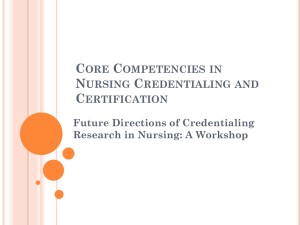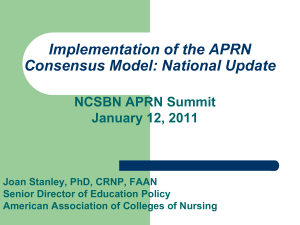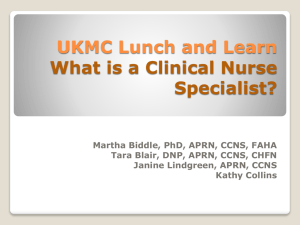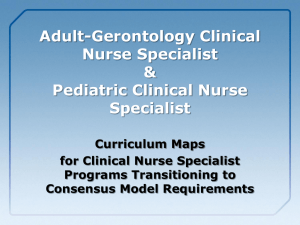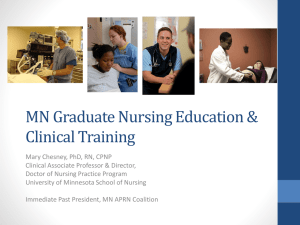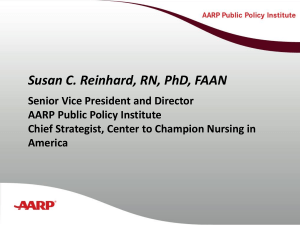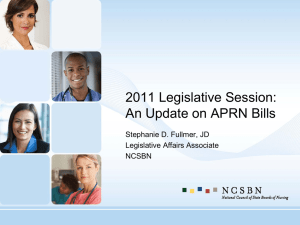Adult/Gerontology APRNs
advertisement
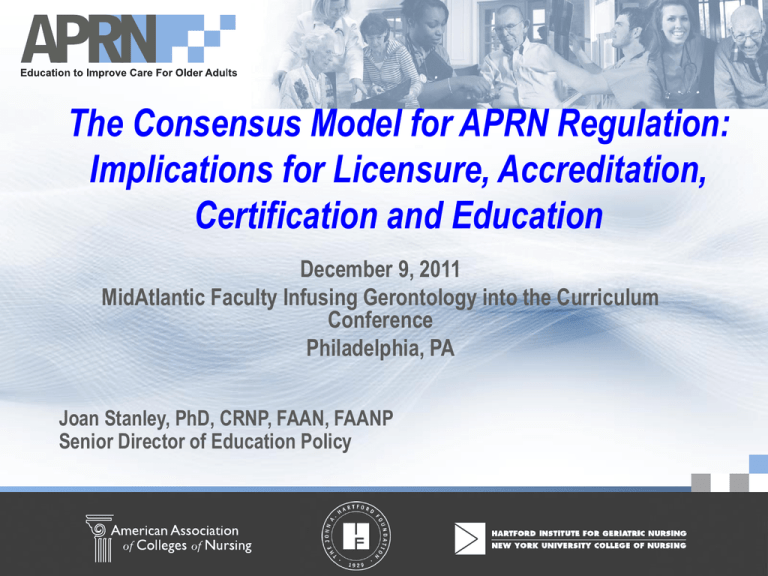
The Consensus Model for APRN Regulation: Implications for Licensure, Accreditation, Certification and Education December 9, 2011 MidAtlantic Faculty Infusing Gerontology into the Curriculum Conference Philadelphia, PA Joan Stanley, PhD, CRNP, FAAN, FAANP Senior Director of Education Policy Objectives • Recognize the implications of the Consensus Model for APRN Regulation for licensure, accreditation, certification, and education programs. • Analyze issues that have arisen secondary to the implementation of the Consensus Model. • Identify resources available to transition to the Adult-Gerontology NP and CNS IOM The Future of Nursing (2010) Key Messages related to APRNs: • Nurses should practice to full extent of their education and training • Nurses should be full partners with physicians and other HPs in redesigning HC in U.S. • Remove scope of practice barriers for APRNs • Expand opportunities for nurses to lead improvement efforts. • Double the number of nurse with a doctorate by 2020 Reaching Consensus: Timeline • March 2004 – AACN & NONPF submitted proposal to Alliance for APRN Credentialing • June 2004 - APN Consensus Conference convened; 32 organizations participated • October 2004 – APN Work Group charged with developing future model for APN • Work group convened 16+ days Oct 2004 and July 2008 • AACN & ANA co-hosted 3 larger Consensus mtgs during same timeframe (> 70 org.) • Feb 2006- NCSBN APRN Committee disseminated draft APRN Vision Paper APRN Consensus Timeline (cont.) • Jan 2007 – APRN Joint Dialogue Group formed, included 7 representatives from Work Group and NCSBN APRN Committee • July 2008 - Consensus Model for APRN Regulation: Licensure, Accreditation, Certification & Education finalized and disseminated • 48 national nursing organizations have endorsed the Model including all major APRN organizations • August 2010 – MOU signed by LACE organizations to create LACE Network (renewed August 2011) LACE Network 30 organizations have committed to supporting and participating in LACE electronic network Ensure transparent and ongoing communication among LACE entities Provide a platform for the ongoing work LACE not a formal, separate organization Based on social networking principles The LACE Network is a communication network that includes organizations that represent the Licensure, Accreditation, Certification, and Education components of APRN regulation. LACE provides a mechanism for communicating about APRN regulatory issues, facilitating implementation of the APRN Consensus Model, and involving all stakeholders in advancing APRN regulation.” LACE Structure Public site (http://www.aprnlace.org) Posting updated information, documents Protected work site (3 seats/organizations 8 Discussion/Work groups : LACE components and four roles Posting documents to be shared and worked on Ongoing dialogue on posted questions Scheduling virtual meetings Calendar Consensus Model for APRN Regulation Finalized in 2008 Endorsed by 48 nursing organizations Implementation began immediately and is actively ongoing Addresses all APRN roles: CRNA, CNM, CNS, CNP Definitions Titling Has implications for all APRN education programs, certifying entities, accrediting bodies, and licensing bodies Projected Timeline for Sequential Implementation of Model Implementation started immediately by all LACE entities Target for full implementation is 2015 APRN education programs should be transitioned by 2012-2013 Accreditation processes should be in place by 2012-2013 Implications for Accreditation of APRN Programs Will pre-approve all new APRN programs Will accredit all post-graduate certificate programs. Will ensure that programs are designed to prepare graduates for national certification/licensure Education program must include 3P’s, nationally recognized role and population competencies CCNE goal is to have processes in place by 20132015 Implications for APRN Certification All APRNs must be nationally certified by a recognized, accredited certifying body Assess APRN core, role/population competencies For licensure, individuals must be certified in the role/population which matches education program Specialty must be tested separately Certification Timeline Certification examinations should be transitioned by 2013 - 2014 NP & CNS certification bodies have indicated that they will maintain the current certification examinations until at least 2014 and possibly 2015 Currently certified NPs and CNSs will be grandfathered if maintain certification Implementation Questions related to Certification Who is eligible to sit for the current exams? Clinical hours, 3P’s Who will be eligible to sit for the new adult-gerontology NP exam? What new exams are needed for the roles/population foci, e.g. psych/MH NP across the lifespan? What specialty certifications are needed or will be developed? Implications for Licensing APRNs State Boards of Nursing will: Implement the APRN legislative language Issue a second APRN license License APRNs as independent practitioners with full prescriptive authority Ensure APRN representation on the Board of Nursing Include a grandfathering clause for those APRNs already practicing Implementation Issues Related to Licensing of APRNs Collecting accurate data regarding implementation by state boards of nursing Clarification to ensure accurate interpretation of Consensus Model as states work to implement and change regulations Acute vs. primary care NP differentiation and scope of practice, practice settings Recognition of all four roles and populations Development of resources for public and state boards www.ncsbn.org/2276.htm Implications for APRN Education Programs Timeline for education programs to transition is projected to be 2012-2013 Ensure that grads eligible for national certification/licensure All new APRN programs/tracks must be preaccredited/pre-approved prior to admitting students All post-graduate certificate APRN programs will need to be accredited by 2015 Implementation Issues for APRN Education Clarification of APRN Core (3 P’s) Official Transcript Differentiation of Acute and Primary Care NP roles Inclusion of wellness in all APRN curricula Enhancing content related to care of older adults in all APRN curricula Implications for APRN Education Programs (cont.) Transcript (or official school document) must: Identify APRN role and population focus of the graduate If a post-graduate certificate program, say that individual completed requirements for a postgraduate certificate in “role/population” APRN Core 3 P’s (separate graduate-level courses) Advanced physiology/pathophysiology, including general principles that apply across the lifespan; (lifespan is defined as prenatal through old age including death). Advanced health assessment, which includes all systems and advanced techniques. Advanced pharmacology, which includes …. all broad categories of agents- not solely for population Specific competencies delineated in 1996 Master’s Essentials & 2006 DNP Essentials www.aacn.nche.edu/Education/essentials.htm APRN REGULATORY MODEL • APRN SPECIALTIES • • • Focus of practice beyond role and population focus linked to health care needs Examples include but are not limited to: Oncology, Older Adults, Orthopedics, Nephrology, Palliative Care Licensure occurs at Levels of Role & Population Foci POPULATION FOCI Family/Individual Across Lifespan AdultGerontology* Neonatal Women’s Health/GenderRelated Pediatrics APRN ROLES Nurse Anesthetist NurseMidwife Clinical Nurse Specialist Nurse Practitioner * PsychiatricMental Health Acute & Primary Care NP The CNP is prepared with the acute care CNP competencies and/or the primary care CNP competencies. Applies only to the pediatric and adultgerontology CNP programs May prepare individuals across both primary care and acute care with both sets of competencies and obtain certification in both.” Example: adult-gero acute care NP & adult-gero primary care NP Building a Curriculum Competencies Professional Certification Specialty Population foci Regulation Role APRN Graduate Core Professional Organizations (e.g. oncology, palliative care, nephrology) NP, CRNA, CNM CNS Core competencies in Population context 3 Ps (Advanced Pathophys, Pharmacology, Health Assessment) 2011 AACN Master’s or 2006 DNP Essentials Incorporation of Wellness in All APRN Curricula “All APRNs are educationally prepared to provide scope of services across health wellness-illness continuum… however emphasis and implementation within each role varies.” Evaluation of curricula Enhancement of certification examinations CNS educated and assessed across the continuum from wellness through acute care Requires review and enhancement of national core competencies for roles and population foci Adult/Gerontology APRNs New Model (fully effective 2015) Does away with separate adult & geriatric programs Combines Adult and Gerontology NP and CNS programs into fully merged Adult-Gerontology NP and CNS programs Requires more geriatrics in family, psych/MH, and women’s health programs Implications for all APRN education programs, certifying entities, accrediting and licensing bodies Enhancing Preparation of APRNs to Care for Older Adult Recommended Competencies for Older Adult Care for Non- Adult-Gerontology APRNs WHNPs & FNPs WH and Across the Lifespan CNSs http://www.aacn.nche.edu/education/nonadultgero.htm Number of Other NP Programs Impacted Type of Program Number of programs Enrollment Graduations Family NP 292 19,145 4,648 Women’s Health NP 53 1,054 306 Adult & Family Psych NP 96 1,166 224 Source: AACN IDS 2010 Adult/Gerontology APRN Competencies Adult-Gerontology Primary Care NP Competencies (2011) Adult-Gerontology Acute Care NP Competencies (2011) Adult-Gerontology CNS Competencies (2011) http://www.aacn.nche.edu/Education/adultgeroco mp.htm Number of NP Programs Impacted Type of program Number of programs Enrollment Graduations Gero NP 62 1,054 306 Adult Primary Care NP 145 4,782 1,209 Adult/Gero Primary Care NP Adult Acute Care NP 27 601 125 66 2,574 665 Source: AACN IDS 2010 Number of CNS Programs Impacted Type of Program Number of programs Enrollment Graduations Gero CNS 28 50 29 Adult CNS 123 1,930 447 Adult/Gero CNS 3 Acute/Critical Care Adult CNS 44 755 145 Source: AACN IDS 2010 Resources LACE Network http://www.aprnlace.org APRN Model Act/Rules and Regulations. https://www.ncsbn.org/APRN_leg_language_approved_8_08.pdf Consensus Model for APRN Regulation: Licensure, Accreditation Certification & Education (July 2008) http://www.aacn.nche.edu/education/pdf/APRNReport.pdf APRN Consensus Model FAQs (8/19/2010) http://www.aacn.nche.edu/education/pdf/LACE_FAQ.pdf Adult-Gerontology NP & CNS Competencies http://www.aacn.nche.edu/Education/adultgerocomp.htm Facilitating Transition to the Adult-Gerontology APRN Curriculum With funding from the John A. Hartford Foundation, AACN and Hartford Institute at NYU have developed/compiled resource materials to support this transition To assist faculty in preparing APRNs to care for older adults New teaching resources developed Faculty development workshops to provide faculty with the knowledge, skills, and tools to enhance gerontology content & support curriculum redesign in NP & CNS programs Faculty Webinars Transitioning to Adult-Gerontology APRN Education Project Introduction, Scope, and Faculty Resource Development October 31, 2011 Strategies and Resources for Teaching Gerontology Content November 9, 2011 Innovative Curriculum Models, Integrating Content, and Clinical Exemplars December 6, 2011 Strategies to Infuse Geropsychiatric Content Intro Nursing Curricula Presented by Geropsychiatric Nursing Collaborative December 15, 1-2:30 PM ET APRN Faculty Resource Center (http://consultgerirn.org/aprncenter) APRN Resource Center: Strategies and Resources for Integrating Gerontology Content – Adult-Gerontology NP & CNS Competencies – Introduction to the Resource Center – Unfolding and Interactive Web-based Case Studies – Content Slide Library and Evidence-based Literature Reviews – Integration of Gerontological Content Worksheet and Instructions Unfolding and Interactive Web-based Case Studies • 15 case studies 12 developed by the Hartford Institute 3 developed by the NACNS • Focus of case studies are for student use • All developed by national experts teaching in programs APRN Gerontology-Focused Case Studies 8 new unfolding case studies for CNSs and NPs Geropsych cases for NP and for CNS Comorbidities for NP and for CNS Polypharmacy Transitional care from acute to subacute to home for NP and for CNS Urinary incontinence Geriatric Resources: Web-based Web-Resources http: //www.ConsultGeriRN.org Try This ® and How to Try This General Assessment Series, e.g. Confusion Assessment Method (CAM) Beers Criteria for Potentially Inappropriate Medication Use in the Elderly Mental Status Assessement of Older Adults: the MiniCog The Geriatric Depression Scale (GDS) http: //www.ConsultGeriRN.org Try This ® and How to Try This Dementia Assessment Series, e.g. Assessing and Managing Delirium in Persons wih Dementia Recognition of Dementia in Hospitalized Older Adults Geriatric Resources: Books Auerhahn, C., Capezuti, E., Flaherty, E., & Resnick, B. (eds.) (2007). Geriatric Nursing Review Syllabus: A Core Curriculum in Advanced Practice Geriatric Nursing, 2nd Edition: New York: American Geriatrics Society. (3rd Edition, May, 2011) • • • A concise & comprehensive text developed by the American Geriatrics Society (AGS) & the NYU Hartford Institute for Geriatric Nursing , adapted for APRNs from the AGS Geriatrics Review Syllabus: A Core Curriculum in Geriatric Medicine, 6th Edition Authored by > 100 interdisciplinary experts in care of older adults 59 chapters on prevailing management strategies, extensive reference, appendix with assessment instruments, 100 case-oriented, multiple choice questions and a self-assessment tool. (www.americangeriatrics.org/.../the_geriatric_nursing_review_syllabus_2nd_edition/ Auerhahn, C. & Kennedy-Malone, L. (2010). Integrating Gerontological Content into Advanced Practice Nursing Education. New York: Springer Publishing Co. • • • • Clear, user-friendly guidelines for integrating gerontological content into non-gerontological APRN programs Detailed lists of print resources and e-Learning materials Utilizes a competency-based framework “Success stories” written by APRN faculty who have integrated gerontological content into non-gerontological courses Innovative Curriculum Models for Both NPs and CNSs Examples of merged/integrated adult and gerontology content in NP and CNS programs nationally Strategies to use these curricula in your own programs Examples of how content integrated into didactic and clinical components of adult-gero program Web-based Content Slide Library Topics of importance for Adult-Gero APRNs *Urinary incontinence *Delirium *Atypical Presentation of Illness *Cardiac Disease in Complex Older Adults • Evidence-based content developed by national experts • Evidence-based lit review of 3 topics (www.HartfordIGN.org) Specialty Nursing Associations Resources Specialty nursing associations (with the Hartford Institute) have geriatric specific resources: • American Association of Critical-Care Nurses (AACN) and American Academy of Nursing (AAN): "Best Practices for Elder Care" online course • American Society for Pain Management Nursing (ASPMN): Curriculum to prepare hospital nurses to be a Geriatric Pain Management Resource Nurse • Association of PeriOperative Registered Nurses (AORN): online Confidence-Based Learning (CBL) Module, “Perioperative Care of the Older Adult” • Emergency Nurses Association (ENA): Universal recommended guidelines for the safer handoff of older adult patients between long-term care (LTC) facilities and emergency departments (ED) Consensus Model Resources APRN Model Act/Rules and Regulations. https://www.ncsbn.org/APRN_leg_language_approved_8_08.pdf Consensus Model for APRN Regulation: Licensure, Accreditation Certification & Education (July 2008) http://www.aacn.nche.edu/education/pdf/APRNReport.pdf APRN Consensus Model FAQs (8/19/2010) http://www.aacn.nche.edu/education/pdf/LACE_FAQ.pdf APRN LACE Network (site for information regarding implementation of LACE and related issues) http://www.APRNLACE.org APRN Resource Center http://consultgerirn.org/aprncenter For additional information or questions: http://www.aacn.nche.edu jstanley@aacn.nche.edu
